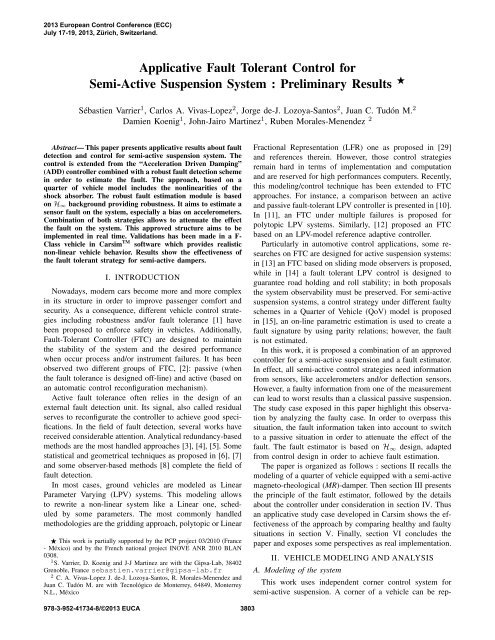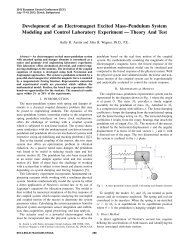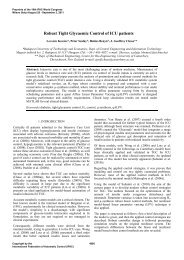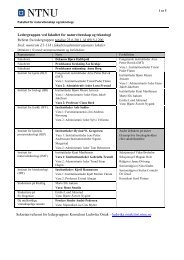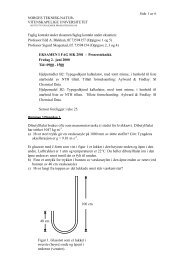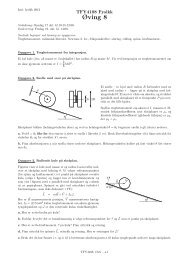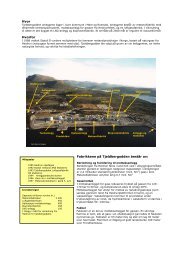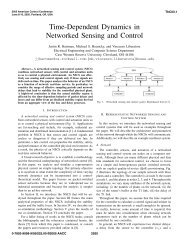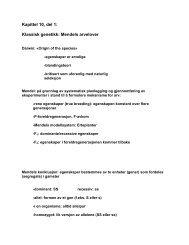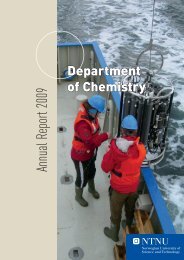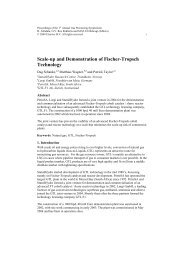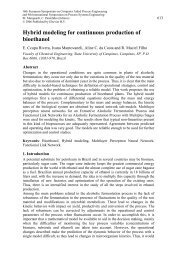Applicative Fault Tolerant Control for Semi-Active Suspension System
Applicative Fault Tolerant Control for Semi-Active Suspension System
Applicative Fault Tolerant Control for Semi-Active Suspension System
You also want an ePaper? Increase the reach of your titles
YUMPU automatically turns print PDFs into web optimized ePapers that Google loves.
2013 European <strong>Control</strong> Conference (ECC)<br />
July 17-19, 2013, Zürich, Switzerland.<br />
<strong>Applicative</strong> <strong>Fault</strong> <strong>Tolerant</strong> <strong>Control</strong> <strong>for</strong><br />
<strong>Semi</strong>-<strong>Active</strong> <strong>Suspension</strong> <strong>System</strong> : Preliminary Results ⋆<br />
Sébastien Varrier 1 , Carlos A. Vivas-Lopez 2 , Jorge de-J. Lozoya-Santos 2 , Juan C. Tudón M. 2<br />
Damien Koenig 1 , John-Jairo Martinez 1 , Ruben Morales-Menendez 2<br />
Abstract— This paper presents applicative results about fault<br />
detection and control <strong>for</strong> semi-active suspension system. The<br />
control is extended from the “Acceleration Driven Damping”<br />
(ADD) controller combined with a robust fault detection scheme<br />
in order to estimate the fault. The approach, based on a<br />
quarter of vehicle model includes the nonlinearities of the<br />
shock absorber. The robust fault estimation module is based<br />
on H ∞ background providing robustness. It aims to estimate a<br />
sensor fault on the system, especially a bias on accelerometers.<br />
Combination of both strategies allows to attenuate the effect<br />
the fault on the system. This approved structure aims to be<br />
implemented in real time. Validations has been made in a F-<br />
Class vehicle in Carsim TM software which provides realistic<br />
non-linear vehicle behavior. Results show the effectiveness of<br />
the fault tolerant strategy <strong>for</strong> semi-active dampers.<br />
I. INTRODUCTION<br />
Nowadays, modern cars become more and more complex<br />
in its structure in order to improve passenger com<strong>for</strong>t and<br />
security. As a consequence, different vehicle control strategies<br />
including robustness and/or fault tolerance [1] have<br />
been proposed to en<strong>for</strong>ce safety in vehicles. Additionally,<br />
<strong>Fault</strong>-<strong>Tolerant</strong> <strong>Control</strong>ler (FTC) are designed to maintain<br />
the stability of the system and the desired per<strong>for</strong>mance<br />
when occur process and/or instrument failures. It has been<br />
observed two different groups of FTC, [2]: passive (when<br />
the fault tolerance is designed off-line) and active (based on<br />
an automatic control reconfiguration mechanism).<br />
<strong>Active</strong> fault tolerance often relies in the design of an<br />
external fault detection unit. Its signal, also called residual<br />
serves to reconfigurate the controller to achieve good specifications.<br />
In the field of fault detection, several works have<br />
received considerable attention. Analytical redundancy-based<br />
methods are the most handled approaches [3], [4], [5]. Some<br />
statistical and geometrical techniques as proposed in [6], [7]<br />
and some observer-based methods [8] complete the field of<br />
fault detection.<br />
In most cases, ground vehicles are modeled as Linear<br />
Parameter Varying (LPV) systems. This modeling allows<br />
to rewrite a non-linear system like a Linear one, scheduled<br />
by some parameters. The most commonly handled<br />
methodologies are the gridding approach, polytopic or Linear<br />
⋆ This work is partially supported by the PCP project 03/2010 (France<br />
- México) and by the French national project INOVE ANR 2010 BLAN<br />
0308.<br />
1 S. Varrier, D. Koenig and J-J Martinez are with the Gipsa-Lab, 38402<br />
Grenoble, France sebastien.varrier@gipsa-lab.fr<br />
2 C. A. Vivas-Lopez J. de-J. Lozoya-Santos, R. Morales-Menendez and<br />
Juan C. Tudón M. are with Tecnológico de Monterrey, 64849, Monterrey<br />
N.L., México<br />
Fractional Representation (LFR) one as proposed in [29]<br />
and references therein. However, those control strategies<br />
remain hard in terms of implementation and computation<br />
and are reserved <strong>for</strong> high per<strong>for</strong>mances computers. Recently,<br />
this modeling/control technique has been extended to FTC<br />
approaches. For instance, a comparison between an active<br />
and passive fault-tolerant LPV controller is presented in [10].<br />
In [11], an FTC under multiple failures is proposed <strong>for</strong><br />
polytopic LPV systems. Similarly, [12] proposed an FTC<br />
based on an LPV-model reference adaptive controller.<br />
Particularly in automotive control applications, some researches<br />
on FTC are designed <strong>for</strong> active suspension systems:<br />
in [13] an FTC based on sliding mode observers is proposed,<br />
while in [14] a fault tolerant LPV control is designed to<br />
guarantee road holding and roll stability; in both proposals<br />
the system observability must be preserved. For semi-active<br />
suspension systems, a control strategy under different faulty<br />
schemes in a Quarter of Vehicle (QoV) model is proposed<br />
in [15], an on-line parametric estimation is used to create a<br />
fault signature by using parity relations; however, the fault<br />
is not estimated.<br />
In this work, it is proposed a combination of an approved<br />
controller <strong>for</strong> a semi-active suspension and a fault estimator.<br />
In effect, all semi-active control strategies need in<strong>for</strong>mation<br />
from sensors, like accelerometers and/or deflection sensors.<br />
However, a faulty in<strong>for</strong>mation from one of the measurement<br />
can lead to worst results than a classical passive suspension.<br />
The study case exposed in this paper highlight this observation<br />
by analyzing the faulty case. In order to overpass this<br />
situation, the fault in<strong>for</strong>mation taken into account to switch<br />
to a passive situation in order to attenuate the effect of the<br />
fault. The fault estimator is based on H ∞ design, adapted<br />
from control design in order to achieve fault estimation.<br />
The paper is organized as follows : sections II recalls the<br />
modeling of a quarter of vehicle equipped with a semi-active<br />
magneto-rheological (MR)-damper. Then section III presents<br />
the principle of the fault estimator, followed by the details<br />
about the controller under consideration in section IV. Thus<br />
an applicative study case developed in Carsim shows the effectiveness<br />
of the approach by comparing healthy and faulty<br />
situations in section V. Finally, section VI concludes the<br />
paper and exposes some perspectives as real implementation.<br />
II. VEHICLE MODELING AND ANALYSIS<br />
A. Modeling of the system<br />
This work uses independent corner control system <strong>for</strong><br />
semi-active suspension. A corner of a vehicle can be rep-<br />
978-3-952-41734-8/©2013 EUCA 3803
esented as a lumped parameter Quarter of Vehicle (QoV)<br />
model illustrated on figure 1. It consists of the sprung mass<br />
Fig. 1.<br />
Quarter of vehicle<br />
ms<br />
k s MR<br />
m us<br />
m s (weight of cabin, power engine, etc), unsprung mass m us<br />
(weight of tire, wheel, arms), the suspension strut and the<br />
stiffness of the tire k t . A suspension strut is composed of<br />
a spring k s , a passive damping element c p , and a variable<br />
damping c v . The road disturbances, z r , excites the QoV<br />
model. The vertical displacements of sprung, and unsprung<br />
masses, z s and z us , result from the ground excitation.<br />
Finally, the dynamic behavior of a Quarter of Vehicle<br />
with a semi-active suspension is described by the following<br />
system of ordinary differential equations:<br />
kt<br />
F<br />
m s¨z s = −F MR − k s z def<br />
m us¨z us = k s z def + F MR − k t (z us − z r )<br />
where m s and m us are the sprung and unsprung mass,<br />
respectively; z def is the suspension deflection; z r represents<br />
the road profile; k s and k t are respectively the stiffness of<br />
the suspension and the tire and F MR the semiactive damping<br />
<strong>for</strong>ce.<br />
The semi-active suspension is represented by an MRdamper,<br />
which can be modeled as the sum of various<br />
<strong>for</strong>ces: a linear viscous friction (F c ), a spring <strong>for</strong>ce (F k )<br />
and an electrically variable <strong>for</strong>ce (F I ) which is subject to<br />
saturations. Thus, the resulting model <strong>for</strong> the damper <strong>for</strong>ce<br />
(F M ) can be stated as:<br />
F M = F I + F c + F k<br />
F M = If c tanh(a 1 ż def + a 2 z def ) + b 1 ż def + b 2 z def (2)<br />
} {{ } } {{ } } {{ }<br />
F I<br />
F c F k<br />
which can be rewritten:<br />
z<br />
z<br />
s<br />
z r<br />
us<br />
(1)<br />
F M = If c ρ 1 + b 1 ż def + b 2 z def (3)<br />
where ρ 1 = tanh(a 1 ż def + a 2 z def ). The parameters f c ,<br />
ρ 1 , a 1 , a 2 , b 1 and b 2 characterize the magneto-rheological<br />
damper and has been obtained thanks to experimental results<br />
[32]. Its value are :<br />
Variable Description Value<br />
I Electric current [A]<br />
f c Dynamic yield <strong>for</strong>ce in the<br />
MR damper model<br />
600.95<br />
[N.A −1 ]<br />
ρ 1 Varying parameter to represent<br />
hysteresis of the<br />
damper<br />
a 1 Pre-yield viscous damping<br />
coefficient in MR damper<br />
37.85<br />
[N.m −1 ]<br />
a 2 Pre-yield viscous damping<br />
coefficient in MR damper<br />
22.15<br />
[N.m −1 ]<br />
Post-yield viscous damping 2,830.86<br />
b 1<br />
b 2<br />
coefficient in MR damper<br />
Post-yield viscous damping<br />
coefficient in MR damper<br />
[N.s.m −1 ]<br />
-7,897.21<br />
[N.s.m −1 ]<br />
In the study, each corner of the vehicle is equipped with 3<br />
sensors: chassis acceleration ¨z s , wheel acceleration ¨z us and<br />
a deflection sensor z def . However, the chassis acceleration<br />
sensor ¨z us is faulty. The fault is considered to be additive.<br />
In effect, most of accelerometers are subject to biases which<br />
can be represented by an additive fault. The dynamical model<br />
given in (1) is completed with the dynamics of the damper<br />
(3). It results a state-space representation of the QoV model<br />
as :<br />
⎡<br />
⎤ ⎡<br />
¨z s<br />
⎢ ż s<br />
⎥<br />
⎣¨z us<br />
⎦ = ⎢<br />
⎣<br />
ż us<br />
} {{ }<br />
ẋ<br />
− b1<br />
m s<br />
− c1 b 1 c 1<br />
⎤ ⎡ ⎤<br />
m s m s m s<br />
ż s<br />
1 0 0 0<br />
⎥ ⎢ z s<br />
⎥<br />
b 1 c 1<br />
m us m us<br />
− b1<br />
m us<br />
− c1+kt ⎦ ⎣ż m us<br />
⎦<br />
us<br />
0 0 1 0 z us<br />
} {{ } } {{ }<br />
⎡<br />
− fcρ1<br />
m s<br />
0<br />
f cρ 1<br />
m us<br />
⎤<br />
A<br />
⎡<br />
− 1 m s<br />
⎤<br />
0<br />
+ ⎢ ⎥<br />
⎣ ⎦ I + ⎢ 0<br />
⎥<br />
⎣ 1 ⎦ F o + ⎢<br />
0<br />
⎥<br />
⎣ k t ⎦ z r (4a)<br />
m us<br />
m us<br />
0<br />
0<br />
0<br />
} {{ } } {{ } } {{ }<br />
B I B F B r<br />
where the measurement vector y provided by the 2 accelerometers<br />
¨z s , ¨z us and the deflection sensor z def is given<br />
by :<br />
⎡ ⎤<br />
¨z s<br />
y = ⎣ ¨z us<br />
⎦<br />
z def<br />
⎡ ⎤<br />
⎡<br />
− b1<br />
m s<br />
− c1 b 1 c 1<br />
⎤ ż s<br />
m s m s m s<br />
= ⎣ b 1 c 1<br />
m us m us<br />
− b1<br />
m us<br />
− c1+kt ⎦ ⎢ z s<br />
⎥<br />
m us ⎣ż us<br />
⎦<br />
0 1 0 −1<br />
} {{ } z us<br />
C<br />
⎡ ⎤ ⎡ ⎤ ⎡ ⎤<br />
− fcρ1<br />
m s<br />
0 1<br />
+ ⎣ f cρ 1 ⎦ I + ⎣ k t ⎦<br />
m us<br />
m us<br />
z r + ⎣0⎦<br />
F o (4b)<br />
0 0 0<br />
} {{ } } {{ } }{{}<br />
D I D r D F<br />
with c 1 = k s + b 2 .<br />
In this model, non linearity of the MR-damper ρ 1 appear<br />
in a linear way in the matrices B I and D I of the system,<br />
⎡<br />
⎤<br />
x<br />
3804
so the system is LPV. Moreover, the system is subject to the<br />
road excitation z r which is considered as a disturbance <strong>for</strong><br />
control and fault estimation. The control input of the system<br />
is the electric current I inside the MR-damper.<br />
B. Analysis of control laws<br />
The QoV model suspension tuning looks <strong>for</strong> good com<strong>for</strong>t,<br />
road holding and safe suspension deflections, [26]:<br />
• The vertical chassis acceleration (¨z s ) response to road<br />
disturbances (z r ), between 0 and 20 Hz, represents<br />
the felt acceleration by the driver, i.e. ride com<strong>for</strong>t<br />
specification.<br />
• The vertical wheel deflection (z us −z r ) response to road<br />
disturbances (z r ), between 0 and 30 Hz represents the<br />
ability of the wheel to stay in contact with the road, i.e.<br />
the road-holding specification.<br />
For road holding the hard damping suspension is desirable,<br />
but it deteriorates the ride com<strong>for</strong>t. The per<strong>for</strong>mance will be<br />
obtained through of the control system focused on com<strong>for</strong>t<br />
and road holding. Hence the goals of the control system are:<br />
(1) the minimization of the vertical acceleration (¨z s ) gain in<br />
the frequency of resonance of the sprung mass, and (2) the<br />
minimization of the tire deflection (z us -z r ), in the frequency<br />
of resonance of the tire deflection<br />
III. FAULT ESTIMATION<br />
The objective of the fault estimation is to estimate the fault<br />
F o in the sensor. The proposed method is based on the H ∞<br />
theory. Since the classical H ∞ approach is generally used<br />
<strong>for</strong> controller synthesis, it can be easily extended <strong>for</strong> fault<br />
detection and estimation. The objective of the synthesis is to<br />
minimize the error of estimation between the fault and its<br />
estimation, Fig. 2.<br />
f 0<br />
˜f<br />
W W<br />
u I<br />
O<br />
G s<br />
ˆf<br />
Fig. 3.<br />
Standard<br />
<strong>Control</strong>ler [ ]<br />
Kc<br />
K s =<br />
K d<br />
Standard<br />
Plant P<br />
[ ] y<br />
u<br />
Problem under standard <strong>for</strong>m<br />
These “weighting filters” W I and W O allow us to specify<br />
the frequency behavior of the closed loop system.<br />
According to the scheme in Fig. 2, the fault estimation<br />
error is given by :<br />
˜f f − ˆf<br />
[ y<br />
= T F o − K e<br />
u<br />
= T F o − K e1 y − K e2 u<br />
]<br />
= T F o − K e2 u − K e1 G QoV u − K e1 G f F o<br />
= (T − K e1 G f )F o − (K e2 + K e1 G QoV )u (5)<br />
It can be shown that the fault estimation is directly affected<br />
by both the fault itself F o and also the control input u.<br />
A good estimation is achieved when the fault error ˜f is<br />
as small as possible. In order to achieve this objective, a<br />
weighting filter W f W f as illustrated in Fig. 4 is introduced<br />
in the output ˜f.<br />
20<br />
Sensitivity of the estimation error<br />
z<br />
S f<br />
0<br />
W f<br />
u<br />
QoV <strong>System</strong><br />
y<br />
Singular Values (dB)<br />
−20<br />
−40<br />
−60<br />
−80<br />
f o<br />
G(s)<br />
−100<br />
H ∞ <strong>Fault</strong><br />
Estimator<br />
Fig. 2.<br />
Matching<br />
Filter<br />
T<br />
f<br />
ˆf<br />
+<br />
-<br />
<strong>Fault</strong> estimation problem<br />
The optimization problem is rewritten in the “standard<br />
<strong>for</strong>m” problem, Fig. 3, where it is added “weighting filters”<br />
W I and W O .<br />
˜f<br />
−120<br />
10 −2 10 0 10 2 10 4<br />
Frequency (rad/s)<br />
Fig. 4. Sensitivity of the estimation error S f and its corresponding<br />
sensitivity filter W f<br />
Its strong attenuation in low frequencies permits to have<br />
a low estimation error ˜f, and so a good fault estimation. On<br />
the other hand, the reader can easily appreciate the interest of<br />
the matching filter T since it allows to specify the frequency<br />
specification of the fault estimation.<br />
Remark 1: In the structure of the fault estimator, it has<br />
been chosen to consider as inputs both : 1 - the output of<br />
3805
<strong>Semi</strong>-active suspension system based on<br />
independent QoV control system<br />
K<br />
k t<br />
m<br />
m<br />
s<br />
2 Zones<br />
MR damper<br />
Model<br />
us<br />
I<br />
z..<br />
s<br />
.<br />
zs<br />
Threshold<br />
..<br />
z us<br />
Fig. 5. F-Class vehicle and the semi-active suspension control system<br />
based on a QoV model.<br />
the system y and 2 - the control input u. This second input<br />
is not mandatory/classical <strong>for</strong> the purpose of fault detection.<br />
However, is presence is clearly justified in this purpose as it<br />
brings a second degree of freedom K e2 appreciated in the<br />
right and side of equation (5).<br />
IV. ADD CONTROLLER<br />
Model-free controllers are the most used in commercial<br />
vehicles; examples of this approach are ground-hook, modified<br />
sky-hook and the mix-1-sensor [28], [23], [27]. Because<br />
of that, a model-free controller based on the On-Off <strong>Semi</strong>-<br />
<strong>Active</strong> OSA control scheme is proposed.<br />
The Acceleration Driven Damping (ADD) was developed<br />
in [30], and [31]. It uses the the signs of the body vertical<br />
acceleration ¨z s and the suspension relative velocity (ż s −ż us )<br />
to select between the minimum and maximum damping<br />
coefficients each sampling time. The main goal <strong>for</strong> this<br />
control approach is to minimize the vertical acceleration. The<br />
control law of the ADD controller is given by the equation<br />
6.<br />
c in (t) = c max if ¨z s (ż s − ż us ) ≥ 0<br />
(6)<br />
c in (t) = c min if ¨z s (ż s − ż us ) < 0<br />
The ADD per<strong>for</strong>mance was studied in [30]. It was demonstrated<br />
that the controller has significant benefits at bandwidths<br />
beyond the sprung mass resonance frequency, but near<br />
this the controller behaves similar to a passive suspension.<br />
For this work, in particular, the ADD control scheme was<br />
selected because its dependance of the vertical acceleration.<br />
This because it uses directly the measured vertical acceleration<br />
to compute the control law and a fail in its measure<br />
impacts strongly on the decision of the damping coefficient.<br />
A. Presentation and Scenario<br />
V. APPLICATION<br />
A F-Class vehicle, is a luxury car highly equipped, with<br />
excellent per<strong>for</strong>mance in handling and com<strong>for</strong>t, detailed<br />
construction, and innovative technology. Specifically <strong>for</strong> this<br />
work, the car selected posses an independent suspension<br />
configuration in each corner, where each one uses an MR<br />
damper, and a deflection sensor.<br />
The MR damper receives the electric current generated<br />
by the ADD controller, Fig.5. The MR damper model, used<br />
.<br />
zus<br />
z r<br />
FDI<br />
ADD<br />
in simulations is two 2-Zones model, which is a modified<br />
version of model in [25], simulates the MR damper <strong>for</strong>ce in<br />
pre-yield and post-yield zones, the gain of damping <strong>for</strong>ce due<br />
to electric current is independent of the velocity of piston:<br />
⎧<br />
⎨<br />
F D =<br />
⎩<br />
c p ż + k p z + c MRpre−yield Iż<br />
c p ż + k p z + c MRpost−yield I ż<br />
|ż|<br />
<strong>for</strong> |ż| < v yield<br />
<strong>for</strong> |ż| > v yield<br />
(7)<br />
where F D is MR-damping <strong>for</strong>ce, k p is the stiffness coefficient,<br />
c p is the damping coefficient, c MRpost−yield is the<br />
damping coefficient in post-yield zone due to electric current,<br />
c MRpreyield is the joint damping coefficient due to electric<br />
current and velocity of piston in pre-yield, and v yield is<br />
the velocity where the MR damping <strong>for</strong>ce yields and the<br />
fluid changes from viscous to non Newtonian. The model<br />
has a precision of 2 % when it simulates a random piston<br />
displacement, [21], under persistent electric current.<br />
The full vehicle simulation was made using CarSim TM .<br />
The axis system is the vehicle-body-fixed system, SAE<br />
standard J670e, [22].<br />
The test was implemented in CarSim TM to evaluate the full<br />
vehicle model, Fig. 6. The test was a Random road profile.<br />
This profile tests the suspension under typical operation<br />
conditions, Fig 6.<br />
Roughness [m]<br />
0.005<br />
0<br />
−0.005<br />
(a) RP roughness<br />
(b) CarSim<br />
Fig. 6.<br />
0 50 100<br />
TM<br />
Longitud [m]<br />
simulation<br />
Implemented test in CarSim TM <strong>for</strong> full vehicle.<br />
The lumped parameters of front and rear QoV models are<br />
needed <strong>for</strong> the controller design. These are obtained from<br />
the vehicle parameters, Table I.<br />
Thus, the sprung mass corresponding to the front left<br />
corner, comprises the vehicle chassis and components. This<br />
mass is supported by the suspension. The unsprung mass<br />
corresponds to the wheel components, links and tire. Both<br />
3806
TABLE I<br />
PARAMETERS OF A F-CLASS VEHICLE IN CARSIM TM MODEL.<br />
0.6<br />
Roll : Comparison of the different controls<br />
Variable Description Value Unit<br />
m sfront Front QoV sprung mass 546.5 Kg<br />
m us QoV unsprung mass 50 kg<br />
k sf Front spring stiffness 83 N/mm<br />
k t All tire stiffness 230 N/mm<br />
(m us ), and (m s ) are obtained from the full vehicle parameters.<br />
The lumped parameters of the QoV model follows a<br />
distribution of the body weight of 60 % in front and 40 %<br />
rear. Hence, a single front corner of the vehicle has a 30 %<br />
of the total body weight.<br />
B. Results<br />
It is added an additive fault F o on the sprung mass<br />
accelerometer :<br />
¨z s = ¨z s,acc + F o<br />
The fault of F o = +10m.s −2 arrives at time t = 10s.<br />
Figure 7 shows the per<strong>for</strong>mance of the H ∞ fault estimator.<br />
Roll [deg]<br />
0.4<br />
0.2<br />
0<br />
−0.2<br />
−0.4<br />
−0.6<br />
<strong>Fault</strong> tolerant <strong>Control</strong><br />
−0.8<br />
0 2 4 6 8 10 12 14 16 18 20<br />
Time [s]<br />
0.2<br />
0.15<br />
Fig. 8.<br />
<strong>Fault</strong>y control<br />
Comparison of the roll<br />
Vertical acceleration : Comparison of the different controls<br />
<strong>Fault</strong>y control<br />
<strong>Fault</strong> tolerant <strong>Control</strong><br />
Estimated fault [m.s −2 ]<br />
12<br />
10<br />
8<br />
6<br />
4<br />
2<br />
Estimated fault<br />
Vertical acceleration [m.s −2 ]<br />
0.1<br />
0.05<br />
0<br />
−0.05<br />
−0.1<br />
−0.15<br />
−0.2<br />
0 2 4 6 8 10 12 14 16 18 20<br />
Time [s]<br />
0<br />
−2<br />
0 5 10 15 20 25<br />
Time [s]<br />
Fig. 9.<br />
Comparison of the vertical acceleration<br />
Fig. 7.<br />
Estimated fault<br />
A reconfiguration mechanism has been also considered in<br />
this study. It consists of a simple switch. In fault free case,<br />
the semi-active control allows to increase the com<strong>for</strong>t of the<br />
passengers. When a fault is detected, the semi-active control<br />
is no more used, and a passive suspension is considered :<br />
{<br />
IADD in fault free case<br />
I =<br />
if there is a fault<br />
I 0<br />
where I 0 represents the nominal value of the current.<br />
In effect, when the fault occurs the control strategy if degraded<br />
since its computation is based on the measurements.<br />
The following figures show the roll (Fig. 8) and vertical<br />
acceleration (Fig. 9) of the vehicle. The classical ADD<br />
controller (solid blue lines) show that the per<strong>for</strong>mances of the<br />
controller are degraded in the presence of the fault (t ≥ 10s).<br />
Nevertheless, red dashed lines show the response of the<br />
accommodated <strong>Control</strong>ler. When a fault is detected, the<br />
controller output is kept constant to a nominal value in order<br />
to achieve per<strong>for</strong>mances of a passive damper. Thanks to this<br />
approach, the per<strong>for</strong>mances are not so degraded.<br />
VI. CONCLUSION<br />
A robust <strong>Fault</strong>-<strong>Tolerant</strong> methodology <strong>for</strong> semi-active suspension<br />
control is presented in this paper. The innovation<br />
in this paper relies in the combination of an approved<br />
control law (namely ADD) and a <strong>Fault</strong> detection approach.<br />
In this paper, the fault detector is made from the H ∞<br />
background. The interest of this approach relies in the robust<br />
design. On the other hand, the ADD controller presents good<br />
per<strong>for</strong>mances <strong>for</strong> com<strong>for</strong>t. However, this paper highlight the<br />
effect of a sensor fault on the system. In effect, it is shown<br />
that the per<strong>for</strong>mances of the ADD controller are degraded<br />
when a fault occurs. The fault accommodation controller<br />
switch to a passive damper when a fault is detected. This<br />
3807
control strategy allows to reduce the bad per<strong>for</strong>mances due<br />
to the fault.<br />
REFERENCES<br />
[1] R.J. Patton, “<strong>Fault</strong> <strong>Tolerant</strong> <strong>Control</strong>: The 1997 Situation”, 3 rd IFAC<br />
SAFEPROCESS, England, August 1997, pp. 1033-1055.<br />
[2] Y. Zhang and J. Jiang, “Bibliographical Review on Reconfigurable<br />
<strong>Fault</strong>-tolerant <strong>Control</strong> <strong>System</strong>s”, Annual Reviews in <strong>Control</strong>, vol. 32,<br />
2008, pp. 229-252.<br />
[3] E. Chow and A. Willsky, “Analytical Redundancy and the Design<br />
of Robust Failure Detection <strong>System</strong>s”, IEEE Trans. on Automatic<br />
<strong>Control</strong>, vol. 1, 1984, pp. 603-619.<br />
[4] R.J. Patton and J. Chen, “A Review of Parity Space Approaches to<br />
<strong>Fault</strong> Diagnosis <strong>for</strong> Aerospace <strong>System</strong>s”, J. of Guidance, <strong>Control</strong> and<br />
Dynamics, vol. 17(2), 1994, pp. 278-285.<br />
[5] J. Gertler, “<strong>Fault</strong> Detection and Isolation Using Parity Relations”,<br />
<strong>Control</strong> Eng. Practice, vol. 5(5), 1997, pp. 653-661.<br />
[6] Basseville, M. and Niki<strong>for</strong>ov, I.V., “Detection of Abrupt Changes -<br />
Theory and Application”, Prentice- Hall, Inc., Englewood Cliffs, N.J.,<br />
1993<br />
[7] Balas, G. and Bokor, J., and Szabo Z. “Invariant subspace <strong>for</strong> lpv<br />
systems and their applications”, IEEE Transactions on Automatic<br />
<strong>Control</strong>, 2003, vol. 48, pp. 2065–2069.<br />
[8] Ding, S. “Model-based <strong>Fault</strong> Diagnosis Techniques”, Springer, Berlin,<br />
2008.<br />
[9] P. Apkarian, P. Gahinet and G. Becker, “Self-scheduled H ∞ <strong>Control</strong> of<br />
Linear Parameter-Varying Sistems: A Design Example”, Automatica,<br />
vol. 31, 1995, pp. 1251-1261.<br />
[10] C. Sloth, T. Esbensen and J. Stoustrup, “<strong>Active</strong> and Pasive <strong>Fault</strong>-<br />
<strong>Tolerant</strong> LPV <strong>Control</strong> of Wind Turbines”, American <strong>Control</strong> Conf.,<br />
USA, Jun-Jul 2010, pp. 4640-4646.<br />
[11] M. Rodrigues, D. Theilliol, S. Aberkane and D. Sauter, “<strong>Fault</strong> <strong>Tolerant</strong><br />
<strong>Control</strong> Design <strong>for</strong> Polytopic LPV <strong>System</strong>s”, Int. J. AMCS, vol. 17(1),<br />
2007, pp. 27-37.<br />
[12] A. Vargas-Martínez, V. Puig, L.E. Garza-Castañón and R. Morales-<br />
Menendez, “MRAC + H ∞ <strong>Fault</strong> <strong>Tolerant</strong> <strong>Control</strong> <strong>for</strong> Linear Parameter<br />
Varying <strong>System</strong>s”, SysTol’10, France, Oct. 2010, pp. 94-99.<br />
[13] A. Chamseddine and H. Noura, “<strong>Control</strong> and Sensor <strong>Fault</strong> Tolerance<br />
of Vehicle <strong>Active</strong> <strong>Suspension</strong>”, IEEE Trans. on <strong>Control</strong> <strong>System</strong>s Tech.,<br />
vol. 16(3), 2008, pp. 416-433.<br />
[14] P. Gáspár, Z. Szabó and J. Bokor, “LPV Design of <strong>Fault</strong>-tolerant<br />
<strong>Control</strong> <strong>for</strong> Road Vehicles”, SysTol’10, France, Oct. 2010, pp. 807-<br />
812.<br />
[15] D. Fischer and R. Isermann, “Mechatronic <strong>Semi</strong>-active and <strong>Active</strong><br />
Vehicle <strong>Suspension</strong>s”, <strong>Control</strong> Engineering Practice, vol. 12, 2004,<br />
pp. 1353-1367.<br />
[16] S. Guo, S. Yang and C. Pan, “Dynamical Modeling of Magnetorheological<br />
Damper Behaviors”, J. of Intell. Mater., Syst. and Struct.,<br />
vol. 17, 2006, pp. 3-14<br />
[17] C. Poussot-Vassal, O. Sename, L. Dugard, P. Gáspár, Z. Szabó and J.<br />
Bokor, “A New <strong>Semi</strong>-active <strong>Suspension</strong> <strong>Control</strong> Strategy through LPV<br />
Technique”, <strong>Control</strong> Eng. Practice, vol. 16, 2008, pp. 1519-1534.<br />
[18] A.L. Do, O. Sename and L. Dugard, “An LPV <strong>Control</strong> Approach <strong>for</strong><br />
<strong>Semi</strong>-<strong>Active</strong> <strong>Suspension</strong> <strong>Control</strong> with Actuator Constraints”, American<br />
<strong>Control</strong> Conf., USA, Ju.-Jul. 2010, pp. 4653-4658.<br />
[19] S. Varrier, D. Koenig and J.J. Martinez, “A Parity Space-Based <strong>Fault</strong><br />
Detection On LPV <strong>System</strong>s : Approach For Vehicle Lateral Dynamics<br />
<strong>Control</strong> <strong>System</strong>”, 8 th IFAC SAFEPROCESS, Mexico, 2012.<br />
[20] S. Varrier, D.Koenig and J.J. Martinez, “Robust <strong>Fault</strong> Detection<br />
<strong>for</strong> Vehicle Lateral Dynamics”, IEEE Conference on Decision and<br />
<strong>Control</strong>, Hawai, 2012.<br />
[21] C. Boggs and L. Borg and J. Ostanek, “Efficient Test Procedures<br />
<strong>for</strong> Characterizing MR Dampers”, ASME 2006 Int. Mechanical Eng<br />
Congress and Exposition, 2006.<br />
[22] T. D. Gillespie, “Fundamentals of Vehicle Dynamics”, SAE Int, 1992.<br />
[23] K. S. Hong and H. C. Sohn and J. K. Hedrick, “Modified Skyhook<br />
<strong>Control</strong> of <strong>Semi</strong>-<strong>Active</strong> <strong>Suspension</strong>s: A New Model, Gain Scheduling,<br />
and Hardware-in-the-Loop Tuning”, J. Dyn. Sys., Meas., <strong>Control</strong>,<br />
March 2002, pp 158–167.<br />
[24] J. Lozoya-Santos and R. Morales-Menendez and O.Sename and R.<br />
Ramirez and L. Dugard, “<strong>Control</strong> Strategies <strong>for</strong> an Automotive <strong>Suspension</strong><br />
with a MR Damper”, IFAC World Conf, 2011<br />
[25] D. Maher and P. Young, “An Insight into Linear Quarter Model<br />
Accuracy”, Vehicle Syst. Dyn., 2011, vol. 49, pp. 463–480<br />
[26] C. Poussot-Vassal and C. Spelta and O. Sename and S.M. Savaresi and<br />
L. Dugard, “Survey and Per<strong>for</strong>mance Evaluation on Some Automotive<br />
<strong>Semi</strong>-<strong>Active</strong> <strong>Suspension</strong> <strong>Control</strong> Methods: A Comparative Study on a<br />
Single-Corner Model”, Annual Reviews in <strong>Control</strong>, 2012, vol. 36, pp.<br />
148–160<br />
[27] S. M. Savaresi and C. Spelta, “A Single-Sensor <strong>Control</strong> Strategy<br />
<strong>for</strong> <strong>Semi</strong>-<strong>Active</strong> <strong>Suspension</strong>s”, <strong>Control</strong> <strong>System</strong>s Technology, IEEE<br />
Transactions on, 2009, vol. 17, pp. 143–152<br />
[28] M. Valasek and M. Novak and Z. Sika and O. Vaculin, “Extended<br />
Ground-Hook – New Concept of <strong>Semi</strong>-<strong>Active</strong> <strong>Control</strong> of Truck<br />
<strong>Suspension</strong>”, Vehicle Syst. Dyn., 1997, vol. 29, pp. 289–303<br />
[29] Robert, D. “Contribution linteraction commande/ordonnancement”<br />
Ph.D. thesis, Institut National Polytechnique de Grenoble, 2007<br />
[30] S. M. Savaresi and E. Silani and S. Brittanti, “Acceleration-Driven-<br />
Damper (ADD): An Optimal <strong>Control</strong> Algorithm <strong>for</strong> Com<strong>for</strong>t-Oriented<br />
<strong>Semi</strong>-<strong>Active</strong> <strong>Suspension</strong>s”, ASME J. Dyn. Syst., Meas., <strong>Control</strong>, 2005,<br />
vol. 129(2), pp. 218–229<br />
[31] S. M. Savaresi and E. Silani and S. Brittanti and N. Porciani, “On<br />
Per<strong>for</strong>mance Evaluation Methods and <strong>Control</strong> Strategies <strong>for</strong> <strong>Semi</strong>-<br />
<strong>Active</strong> <strong>Suspension</strong> <strong>System</strong>s”, 42nd <strong>Control</strong> and Decision Conference,<br />
2003, pp. 2264–2269<br />
[32] J.-d.-J. Lozoya-S., R. Morales-M., R. Ramirez-M., J.-C. Tudón-M., O.<br />
Sename, L. Dugard, “Magneto-Rheological damper - an experimental<br />
study”, Journal of Intelligent Material <strong>System</strong>s and Structures 23, 11<br />
(2012), pp. 1213–1232<br />
3808


